Wearable Cardiorespiratory Sensors for Aerospace Applications †
Abstract
:1. Introduction
Cardiorespiratory Sensing in the CHMI2 Framework
2. Models and Methods
2.1. Performance Characterisation of Cardiorespiratory Measurements
2.2. Real Time Data Streaming and Processing Protocols
2.3. Propagation of Uncertainty across a Neuro-Fuzzy Inference Process
2.4. Experiment Design and Raw Measurement Data Processing
3. Sensor Characterisation Results
3.1. Uncertainty in the Inference System
4. Discussion of Results
5. Conclusions
Author Contributions
Funding
Institutional Review Board Statement
Informed Consent Statement
Data Availability Statement
Conflicts of Interest
References
- Jeannot, E.; Kelly, C.; Thompson, D. The Development of Situation Awareness Measures in ATM Systems. EATMP Rep. 2003. Available online: https://www.semanticscholar.org/paper/The-Development-of-Situation-Awareness-Measures-in-Jeannot-Thompson/fea68619b429499881bb42ebddd5e0f652346f33 (accessed on 12 June 2022).
- Sulistyawati, K.; Wickens, C.D.; Chui, Y.P. Prediction in Situation Awareness: Confidence Bias and Underlying Cognitive Abilities. Int. J. Aviat. Psychol. 2011, 21, 153–174. [Google Scholar] [CrossRef]
- Lim, Y.; Gardi, A.; Sabatini, R.; Ramasamy, S.; Kistan, T.; Ezer, N.; Vince, J.; Bolia, R. Avionics Human-Machine Interfaces and Interactions for Manned and Unmanned Aircraft. Prog. Aerosp. Sci. 2018, 102, 1–46. [Google Scholar] [CrossRef]
- Borghini, G.; Aricò, P.; Di Flumeri, G.; Cartocci, G.; Colosimo, A.; Bonelli, S.; Golfetti, A.; Imbert, J.P.; Granger, G.; Benhacene, R.; et al. EEG-Based Cognitive Control Behaviour Assessment: An Ecological study with Professional Air Traffic Controllers. Sci. Rep. 2017, 7, 547. [Google Scholar] [CrossRef]
- Mansikka, H.; Simola, P.; Virtanen, K.; Harris, D.; Oksama, L. Fighter pilots’ heart rate, heart rate variation and performance during instrument approaches. Ergonomics 2016, 59, 1344–1352. [Google Scholar] [CrossRef]
- Sompagnimdi, M.T.; Hurter, C. Exploratory Study with Eye Tracking Devices to Build Interactive Systems for Air Traffic Controllers. In Proceedings of the HCI-Aero ‘16: International Conference on Human-Computer Interaction in Aerospace, Paris, France, 14–16 September 2016; pp. 1–9. [Google Scholar]
- Amos, B.; Ludwiczuk, B.; Satyanarayanan, M. Openface: A general-purpose face recognition library with mobile applications. CMU Sch. Comput. Sci. 2016, 6, 20. [Google Scholar]
- Fydanaki, A.; Geradts, Z. Evaluating OpenFace: An open-source automatic facial comparison algorithm for forensics. Forensic Sci. Res. 2018, 3, 202–209. [Google Scholar] [CrossRef]
- Fayek, H.M.; Lech, M.; Cavedon, L. Evaluating deep learning architectures for Speech Emotion Recognition. Neural Netw. 2017, 92, 60–68. [Google Scholar] [CrossRef]
- Vukovic, M.; Sethu, V.; Parker, J.; Cavedon, L.; Lech, M.; Thangarajah, J. Estimating cognitive load from speech gathered in a complex real-life training exercise. Int. J. Hum. Comput. Stud. 2019, 124, 116–133. [Google Scholar] [CrossRef]
- Huang, Z.; Dong, M.; Mao, Q.; Zhan, Y. Speech Emotion Recognition Using CNN. In Proceedings of the 22nd ACM International Conference on Multimedia, Orlando, FL, USA, 3–7 November 2014. [Google Scholar]
- Lim, W.; Jang, D.; Lee, T. Speech emotion recognition using convolutional and Recurrent Neural Networks. In Proceedings of the 2016 Asia-Pacific Signal and Information Processing Association Annual Summit and Conference (APSIPA), Jeju, South Korea, 13–16 December 2016; pp. 1–4. [Google Scholar] [CrossRef]
- Pongsakornsathien, N.; Lim, Y.; Gardi, A.; Hilton, S.; Planke, L.; Sabatini, R. Sensor Networks for Aerospace Human-Machine Systems. Sensors 2019, 19, 3465. [Google Scholar] [CrossRef] [Green Version]
- Lim, Y.; Gardi, A.; Pongsakornsathien, N.; Sabatini, R.; Ezer, N.; Kistan, T. Experimental characterisation of eye-tracking sensors for adaptive human-machine systems. Measurement 2019, 140, 151–160. [Google Scholar] [CrossRef]
- Nunan, G.D.; Donovan, D.G.; Jakovljevic, R.H.D.; Hodges, A.L.; Sandercock, A.G.; Brodie, A.D. Validity and Reliability of Short-Term Heart-Rate Variability from the Polar S810. Med. Sci. Sports Exerc. 2009, 41, 243–250. [Google Scholar] [CrossRef]
- Hailstone, J.; Kilding, A.E. Reliability and Validity of the Zephyr BioHarness to Measure Respiratory Responses to Exercise. Meas. Phys. Educ. Exerc. Sci. 2011, 15, 293–300. [Google Scholar] [CrossRef]
- Johnstone, J.A.; Ford, P.A.; Gerwyn, H.; Watson, T.; Garrett, A.T. BioHarness Multivariable Monitoring Device: Part I: Validity. J. Sports Sci. Med. 2012, 11, 400–408. [Google Scholar]
- Johnstone, J.A.; Ford, P.A.; Hughes, G.; Watson, T.; Garrett, A.T. Bioharness Multivariable Monitoring Device: Part II: Reliability. J. Sports Sci. Med. 2012, 11, 409–417. [Google Scholar]
- Smith, D.L.; Haller, J.M.; Dolezal, B.A.; Cooper, C.B.; Fehling, P.C. Evaluation of a Wearable Physiological Status Monitor during Simulated Firefighting Activities. J. Occup. Environ. Hyg. 2013, 11, 427–433. [Google Scholar] [CrossRef]
- Flanagan, D.S.; Comstock, A.B.; Dupont, H.W.; Sterczala, R.A.; Looney, P.D.; Dombrowski, H.D. Concurrent Validity of the Armour39 Heart Rate Monitor Strap. J. Strength Cond. Res. 2014, 28, 870–873. [Google Scholar] [CrossRef]
- Dolezal, B.; Boland, D.; Carney, J.; Abrazado, M.; Smith, D.; Cooper, C. Validation of Heart Rate Derived from a Physiological Status Monitor-Embedded Compression Shirt against Criterion ECG. J. Occup. Environ. Hyg. 2014, 11, 833–839. [Google Scholar] [CrossRef]
- Rawstorn, J.C.; Gant, N.; Warren, I.; Doughty, R.N.; Lever, N.; Poppe, K.K.; Maddison, R. Measurement and Data Transmission Validity of a Multi-Biosensor System for Real-Time Remote Exercise Monitoring Among Cardiac Patients. JMIR Rehabil. Assist. Technol. 2015, 2, e3633. [Google Scholar] [CrossRef] [Green Version]
- Nazari, G.; Bobos, P.; MacDermid, J.C.; Sinden, K.E.; Richardson, J.; Tang, A. Psychometric properties of the Zephyr bioharness device: A systematic review. BMC Sports Sci. Med. Rehabil. 2018, 10, 6. [Google Scholar] [CrossRef] [Green Version]
- Galli, A.; Narduzzi, C.; Giorgi, G. Measuring Heart Rate During Physical Exercise by Subspace Decomposition and Kalman Smoothing. IEEE Trans. Instrum. Meas. 2018, 67, 1102–1110. [Google Scholar] [CrossRef]
- Nazari, G.; Macdermid, J.C.; Kin, K.E.S.R.; Richardson, J.; Tang, A. Reliability of Zephyr Bioharness and Fitbit Charge Measures of Heart Rate and Activity at Rest, During the Modified Canadian Aerobic Fitness Test and Recovery. J. Strength Cond. Res. 2019, 33, 559–571. [Google Scholar] [CrossRef]
- Kaber, D.B.; Perry, C.M.; Segall, N.; Sheik-Nainar, M.A. Workload State Classification with Automation During Simulated Air Traffic Control. Int. J. Aviat. Psychol. 2007, 17, 371–390. [Google Scholar] [CrossRef]
- Vogt, J.; Hagemann, T.; Kastner, M. The Impact of Workload on Heart Rate and Blood Pressure in En-Route and Tower Air Traffic Control. J. Psychophysiol. 2006, 20, 297–314. [Google Scholar] [CrossRef]
- Taj-Eldin, M.; Ryan, C.; O’Flynn, B.; Galvin, P. A Review of Wearable Solutions for Physiological and Emotional Monitoring for Use by People with Autism Spectrum Disorder and Their Caregivers. Sensors 2018, 18, 4271. [Google Scholar] [CrossRef] [Green Version]
- Wilson, G.F. An Analysis of Mental Workload in Pilots During Flight Using Multiple Psychophysiological Measures. Int. J. Aviat. Psychol. 2002, 12, 3–18. [Google Scholar] [CrossRef]
- Bonner, M.A.; Wilson, G.F. Heart Rate Measures of Flight Test and Evaluation. Int. J. Aviat. Psychol. 2002, 12, 63–77. [Google Scholar] [CrossRef]
- Lahtinen, T.; Koskelo, J.P.; Laitinen, T.; Leino, T. Heart rate and performance during combat missions in a flight simulator. Aviat. Space Environ. Med. 2007, 78, 387–391. [Google Scholar]
- Hankins, T.C.; Wilson, G.F. A comparison of heart rate, eye activity, EEG and subjective measures of pilot mental workload during flight. Aviat. Space Environ. Med. 1998, 69, 360–367. [Google Scholar]
- Pongsakornsathien, N.; Gardi, A.; Lim, Y.; Sabatini, R.; Kistan, T.; Ezer, N. Performance Characterisation of Wearable Cardiac Monitoring Devices for Aerospace Applications. In Proceedings of the IEEE International Workshop on Metrology for AeroSpace (MetroAeroSpace), Torino, Italy, 19–21 June 2019. [Google Scholar]
- Lim, Y.; Ramasamy, S.; Gardi, A.; Kistan, T.; Sabatini, R. Cognitive Human-Machine Interfaces and Interactions for Unmanned Aircraft. J. Intell. Robot. Syst. 2018, 91, 755–774. [Google Scholar] [CrossRef]
- Liu, J.; Gardi, A.; Ramasamy, S.; Lim, Y.; Sabatini, R. Cognitive pilot-aircraft interface for single-pilot operations. Knowl. Based Syst. 2016, 112, 37–53. [Google Scholar] [CrossRef]
- Ivonin, L.; Chang, H.-M.; Chen, W.; Rauterberg, M. Automatic recognition of the unconscious reactions from physiological signals. In Proceedings of the International Conference on Human Factors in Computing and Informatics, Maribor, Slovenia, 1–3 July 2013; pp. 16–35. [Google Scholar]
- Bradley, M.M.; Miccoli, L.; Escrig, M.A.; Lang, P.J. The pupil as a measure of emotional arousal and autonomic activation. Psychophysiology 2008, 45, 602–607. [Google Scholar] [CrossRef] [PubMed] [Green Version]
- Kwon, O.; Jeong, J.; Kim, H.B.; Kwon, I.H.; Park, S.Y.; Kim, J.E.; Choi, Y. Electrocardiogram Sampling Frequency Range Acceptable for Heart Rate Variability Analysis. Healthc. Inform. Res. 2018, 24, 198–206. [Google Scholar] [CrossRef] [PubMed]
- Kim, J.H.; Roberge, R.; Powell, J.B.; Shafer, A.B.; Williams, J.W. Measurement accuracy of heart rate and respiratory rate during graded exercise and sustained exercise in the heat using the Zephyr BioHarness. Int. J. Sports Med. 2013, 34, 497–501. [Google Scholar] [CrossRef] [PubMed] [Green Version]
- Biopac Systems. Product Sheet—BioHarness Data Logger and Telemetry Physiology Monitoring System, Datasheet. Available online: https://www.biopac.com/wp-content/uploads/BioHarness-BT.pdf (accessed on 5 October 2021).
- Simonetta, G.; Aziz, N.; Forrester, K. Recent developments in data recording systems for Physiology. Pak. J. Physiol. 2006, 2, 34–37. [Google Scholar]
- 802.15.4-2015; Standard for Low-Rate Wireless Networks. Institute of Electrical and Electronics Engineers (IEEE): Piscataway, NJ, USA, 2015.
- 802.15.1-2005; Part 15.1: Wireless Medium Access Control (MAC) and Physical Layer (PHY) Specifications for Wireless Personal Area Networks (WPANs). Institute of Electrical and Electronics Engineers (IEEE): Piscataway, NJ, USA, 2015.
- Kothe, C. Lab streaming Layer (LSL). In Proceedings of the IEEE International Conference on Systems, Man and Cybernetics (SMC), Bari, Italy, 6–9 October 2019. [Google Scholar]
- Miyamoto, S.A.; Ichihashi, H.; Honda, K. Algorithms for Fuzzy Clustering Methods in c-Means Clustering with Applications; Springer: Berlin/Heidelberg, Germany, 2008. [Google Scholar]
- Jang, J.-S.R. ANFIS: Adaptive-network-based fuzzy inference system. IEEE Trans. Syst. Man Cybern. 1993, 23, 665–685. [Google Scholar] [CrossRef]
- Fallahi, M.; Motamedzade, M.; Heidarimoghadam, R.; Soltanian, A.R.; Miyake, S. Effects of mental workload on physiological and subjective responses during traffic density monitoring: A field study. Appl. Ergon. 2016, 52, 95–103. [Google Scholar] [CrossRef]
- Marinescu, A.C.; Sharples, S.; Ritchie, A.C.; Lopez, T.S.; McDowell, M.; Morvan, H.P. Physiological parameter response to variation of mental workload. Hum. Factors 2018, 60, 31–56. [Google Scholar] [CrossRef] [Green Version]
- Avram, R.; Tison, G.H.; Aschbacher, K.; Kuhar, P.; Vittinghoff, E.; Butzner, M.; Runge, R.; Wu, N.; Pletcher, M.J.; Marcus, G.M.; et al. Real-world heart rate norms in the Health eHeart study. NPJ Digit. Med. 2019, 2, 58. [Google Scholar] [CrossRef]
- Jang, J.-S.R.; Sun, C.-T. Neuro-fuzzy modeling and control. Proc. IEEE 1995, 83, 378–406. [Google Scholar] [CrossRef]
- Jang, J.-S.R.; Sun, C.-T. Neuro-Fuzzy and Soft Computing: A Computational Approach to Learning and Machine Intelligence; Prentice Hall: Upper Saddle River, NJ, USA, 1997. [Google Scholar]
- Tato, A.; Nkambou, R.; Ghali, R. Towards Predicting Attention and Workload During Math Problem Solving. In Proceedings of the International Conference on Intelligent Tutoring Systems, Kingston, Jamaica, 3–7 June 2019; pp. 224–229. [Google Scholar]
- Shaffer, F.; Ginsberg, J.P. An Overview of Heart Rate Variability Metrics and Norms. Front. Public Health 2017, 5, 258. [Google Scholar] [CrossRef] [Green Version]
- Van Stralen, K.J.; Jager, K.J.; Zoccali, C.; Dekker, F.W. Agreement between methods. Kidney Int. 2008, 74, 1116–1120. [Google Scholar] [CrossRef] [PubMed] [Green Version]
- Vlemincx, E.; Taelman, J.; de Peuter, S.; van Diest, I.; van den Bergh, O. Sigh rate and respiratory variability during mental load and sustained attention. Psychophysiology 2010, 48, 117–120. [Google Scholar] [CrossRef] [PubMed]
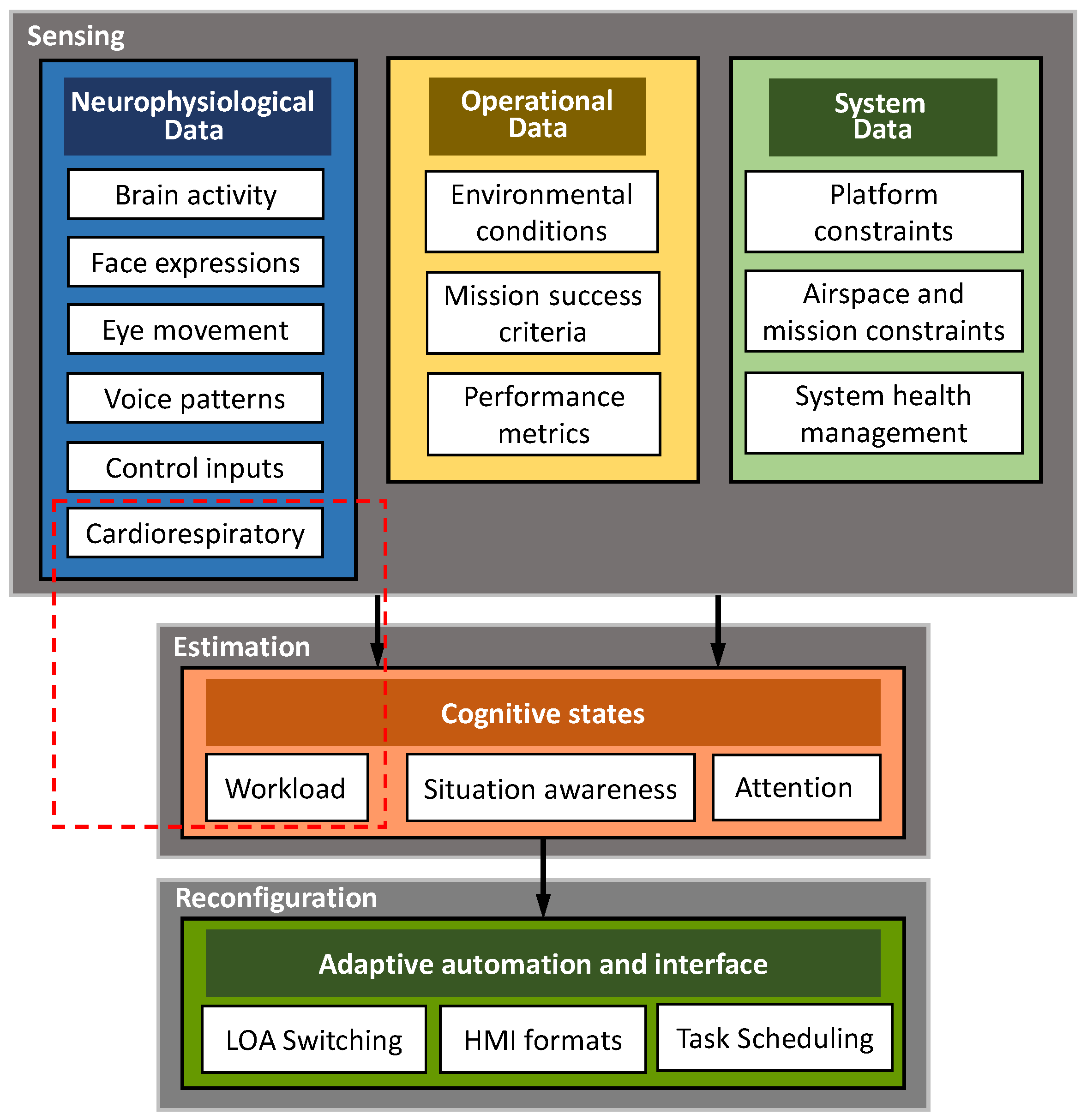


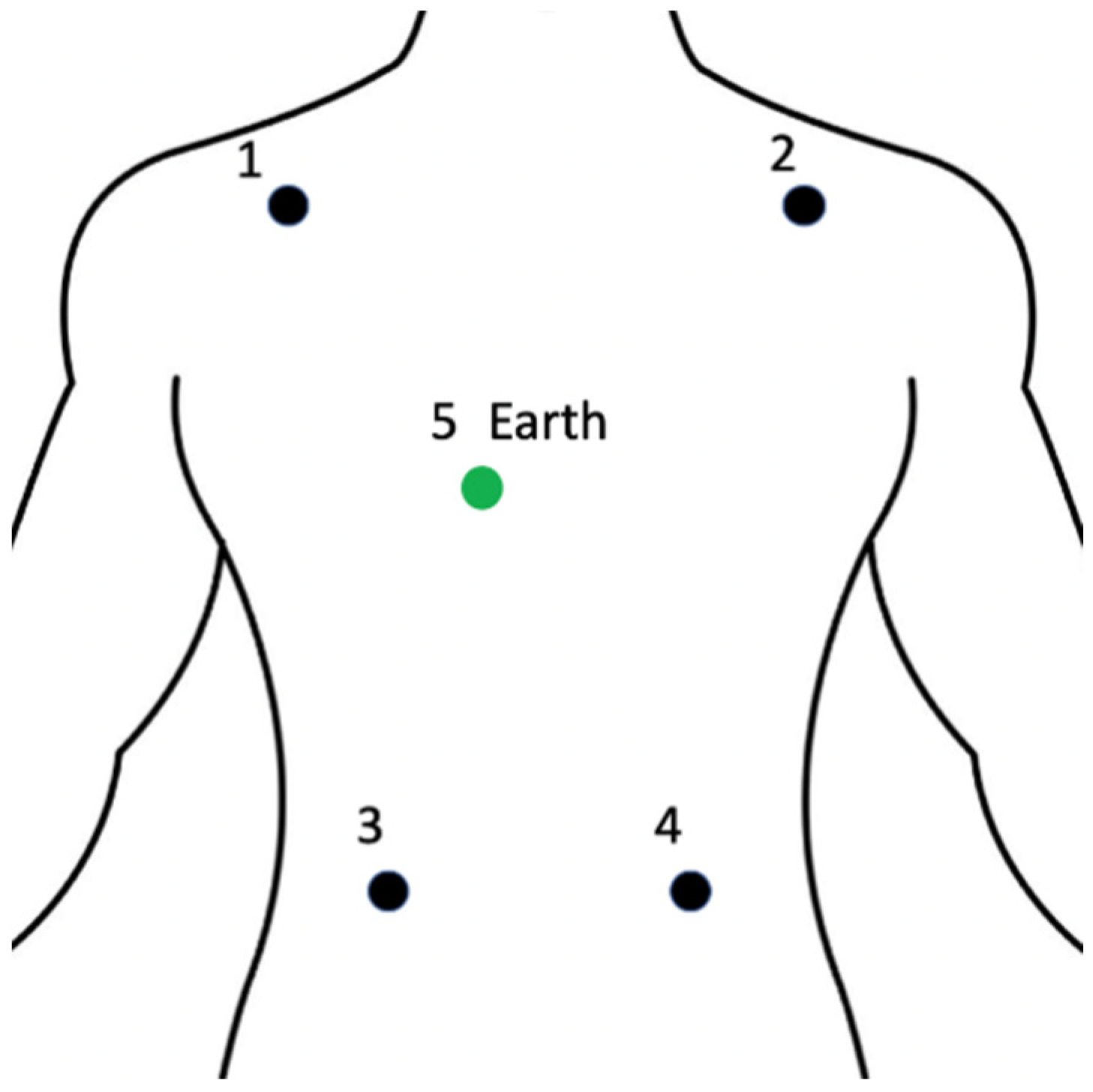
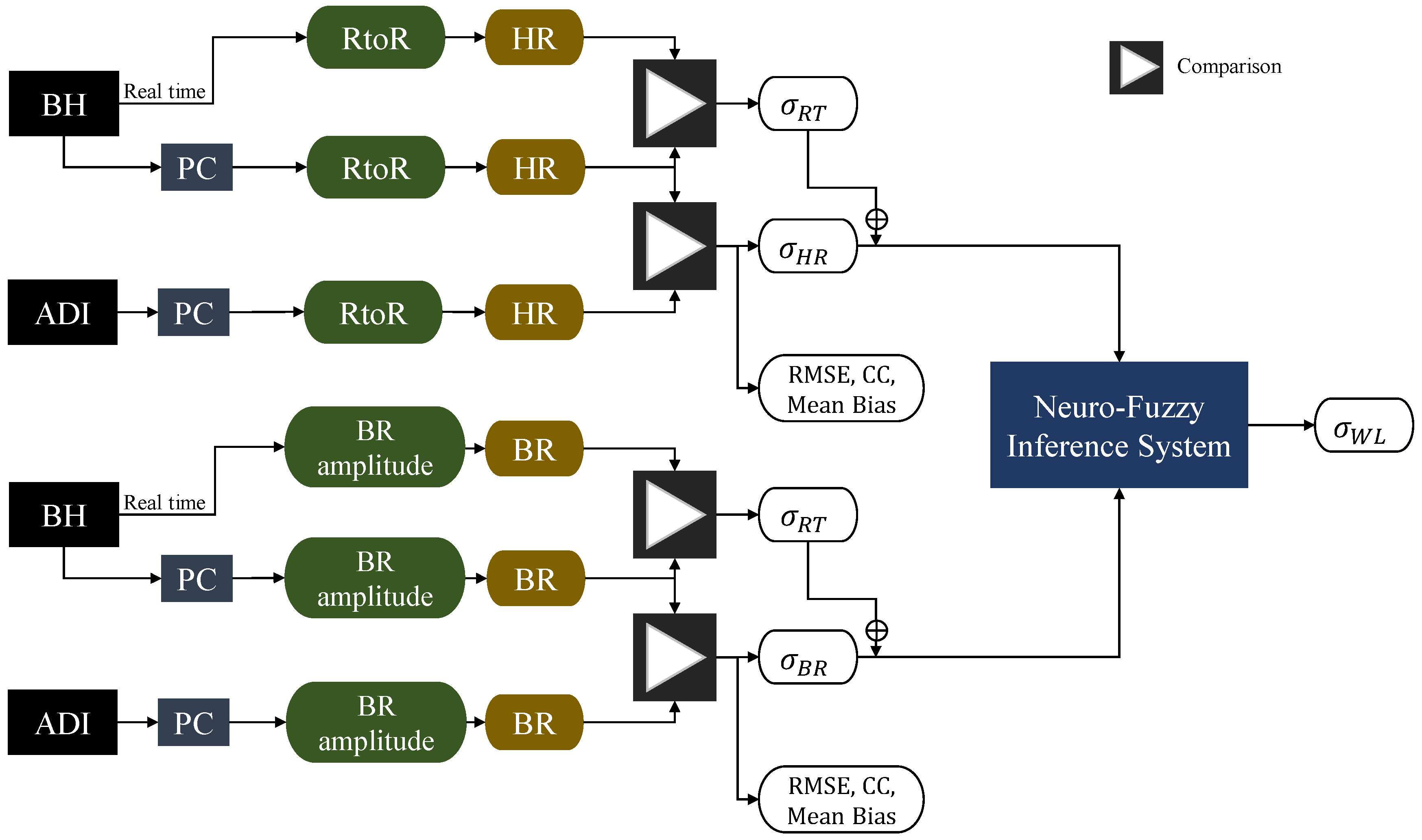
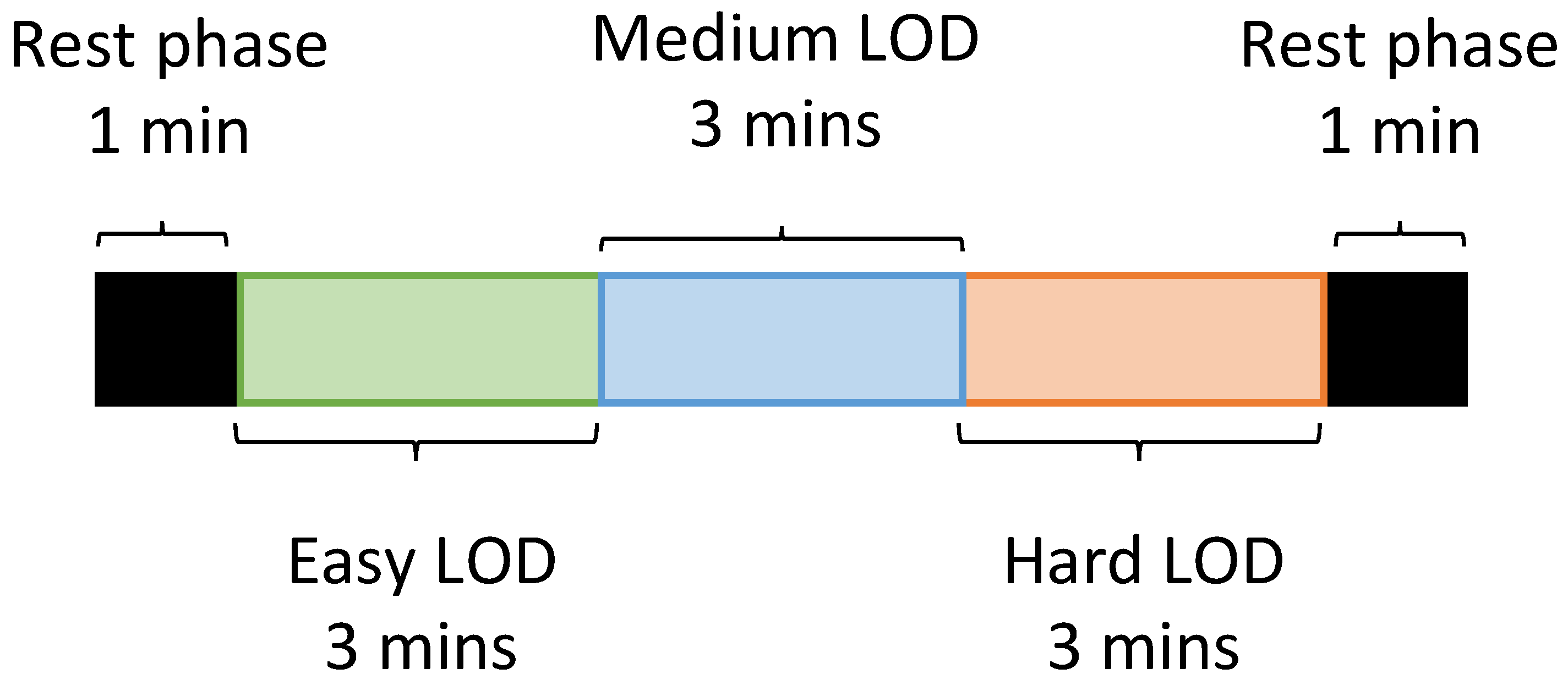
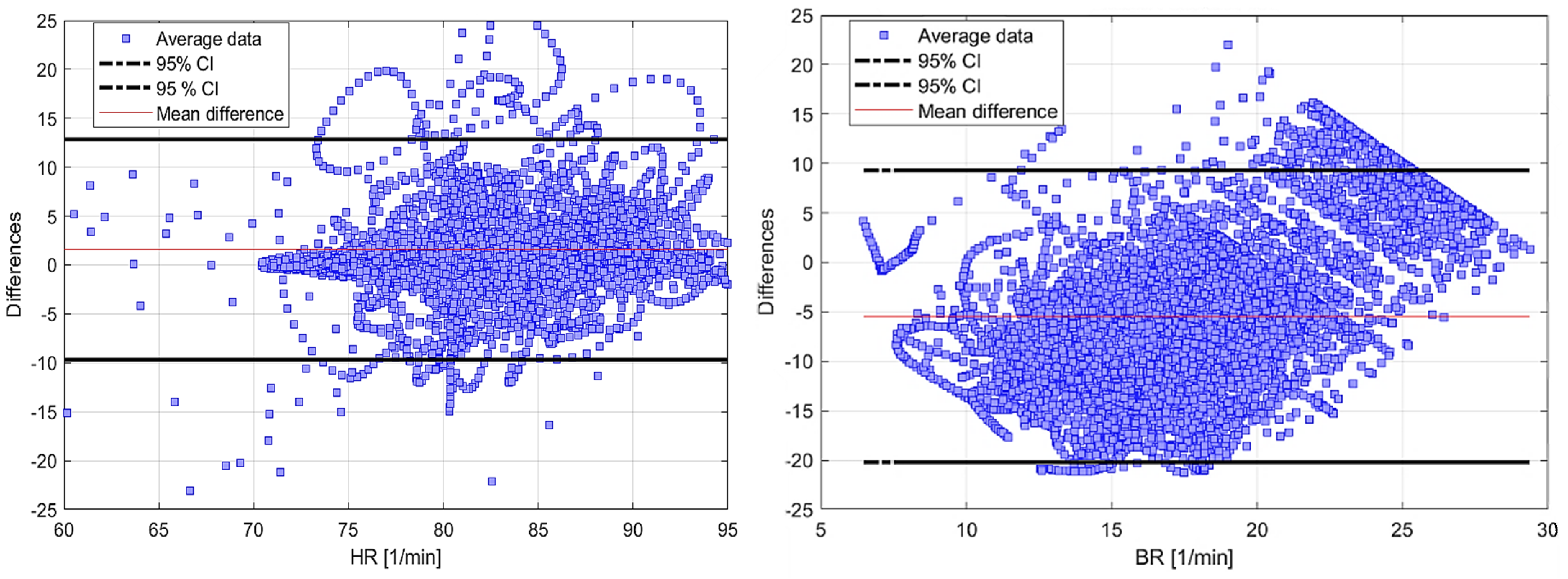
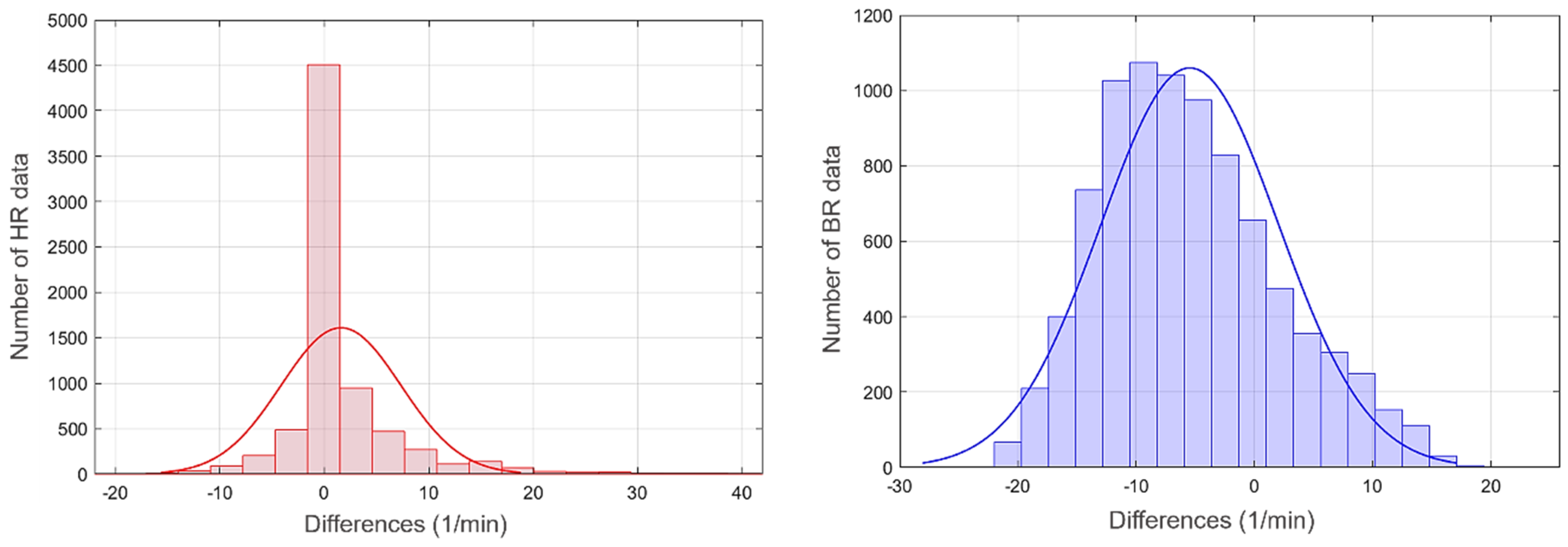
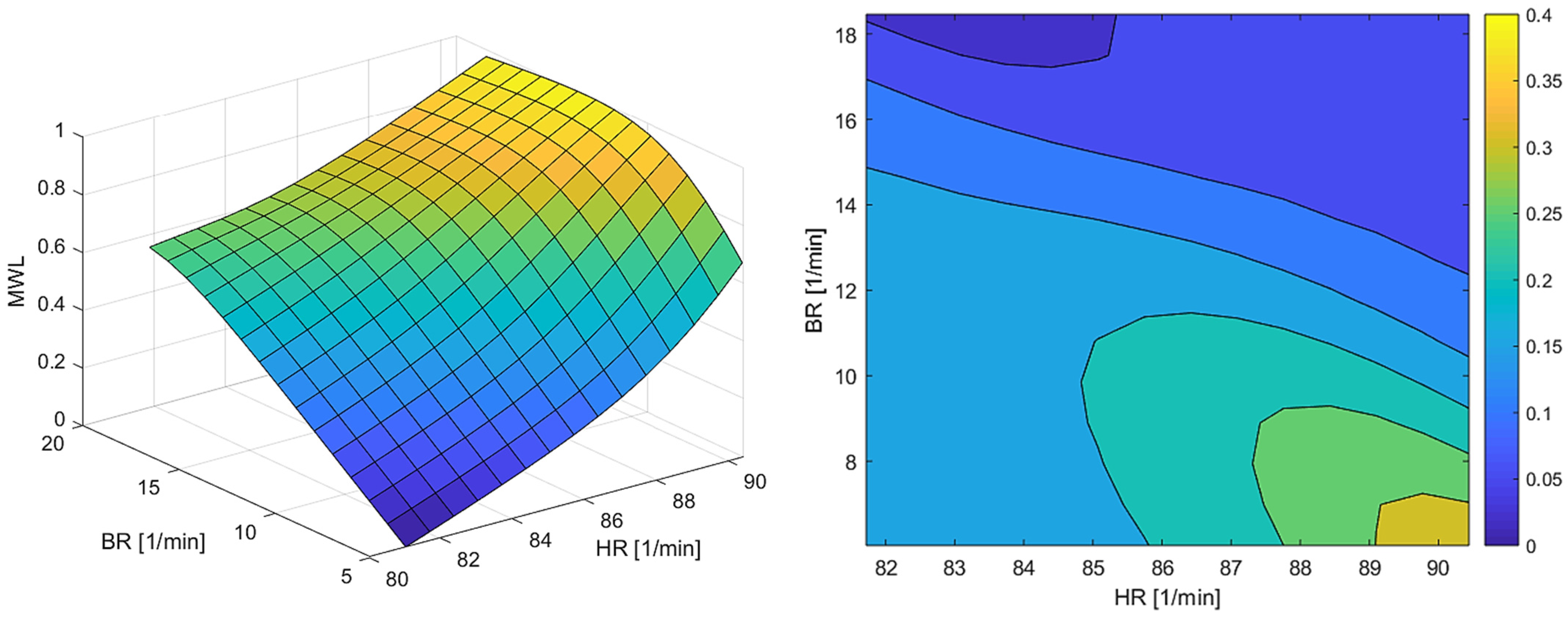
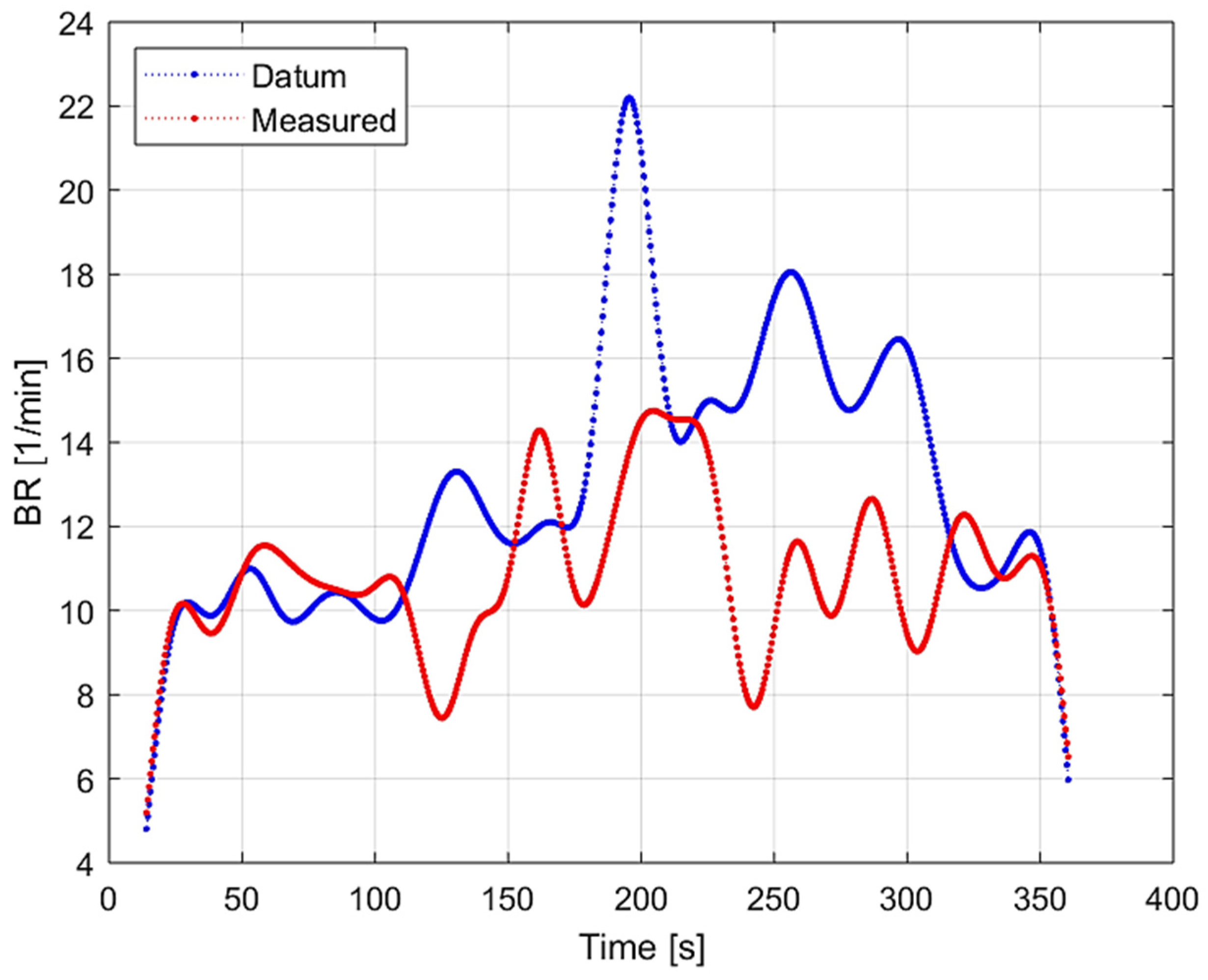
| RMSE [1/min] | [1/min] | CC | Mean Bias [1/min] | |
|---|---|---|---|---|
| HR | 4.852 | 4.109 | 0.663 | 1.901 |
| HR min error | 0.728 | 0.720 | 0.990 | −1.511 |
| HR max error | 14.86 | 10.55 | 0.319 | 10.48 |
| BR | −9.729 | 7.394 | 0.087 | −6.003 |
| BR min error | −7.958 | 6.534 | 0.188 | −2.771 |
| BR max error | −12.94 | 8.024 | 0.029 | −15.80 |
| Best | 0.720 | 6.534 | −0.560 | 0.376 |
| Worst | 2.491 | 7.433 | 17.49 | 2.220 |
| Average | 4.109 | 7.394 | 0.850 | 1.329 |
| % Decrease | ||
|---|---|---|
| Best | 0.125 | 33.39 |
| Worst | 1.211 | 45.45 |
| Average | 0.811 | 38.96 |
Publisher’s Note: MDPI stays neutral with regard to jurisdictional claims in published maps and institutional affiliations. |
© 2022 by the authors. Licensee MDPI, Basel, Switzerland. This article is an open access article distributed under the terms and conditions of the Creative Commons Attribution (CC BY) license (https://creativecommons.org/licenses/by/4.0/).
Share and Cite
Pongsakornsathien, N.; Gardi, A.; Lim, Y.; Sabatini, R.; Kistan, T. Wearable Cardiorespiratory Sensors for Aerospace Applications. Sensors 2022, 22, 4673. https://doi.org/10.3390/s22134673
Pongsakornsathien N, Gardi A, Lim Y, Sabatini R, Kistan T. Wearable Cardiorespiratory Sensors for Aerospace Applications. Sensors. 2022; 22(13):4673. https://doi.org/10.3390/s22134673
Chicago/Turabian StylePongsakornsathien, Nichakorn, Alessandro Gardi, Yixiang Lim, Roberto Sabatini, and Trevor Kistan. 2022. "Wearable Cardiorespiratory Sensors for Aerospace Applications" Sensors 22, no. 13: 4673. https://doi.org/10.3390/s22134673
APA StylePongsakornsathien, N., Gardi, A., Lim, Y., Sabatini, R., & Kistan, T. (2022). Wearable Cardiorespiratory Sensors for Aerospace Applications. Sensors, 22(13), 4673. https://doi.org/10.3390/s22134673






